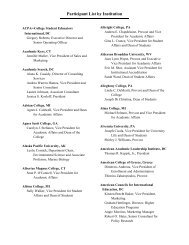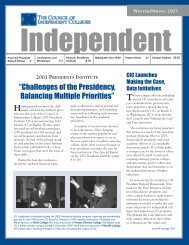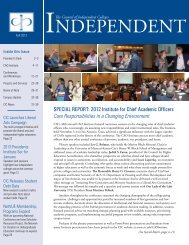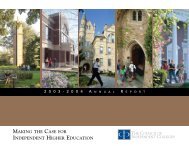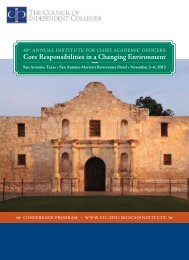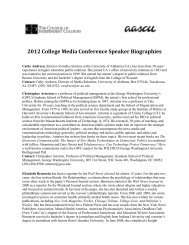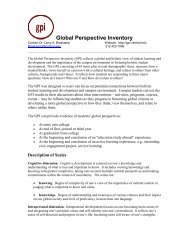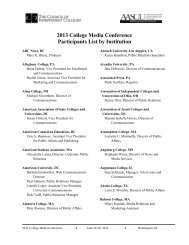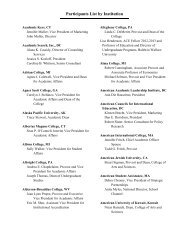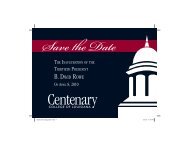Summer 2009 - The Council of Independent Colleges
Summer 2009 - The Council of Independent Colleges
Summer 2009 - The Council of Independent Colleges
Create successful ePaper yourself
Turn your PDF publications into a flip-book with our unique Google optimized e-Paper software.
PRESIDENT’S DESK<br />
Board <strong>of</strong> Directors<br />
Executive Committee<br />
John Strassburger, Ursinus College (Chair)<br />
Phillip L. Dudley, Hastings College<br />
Beverly W. Hogan, Tougaloo College<br />
David Joyce, Ripon College<br />
George E. Martin, St. Edward’s University<br />
G. David Pollick, Birmingham-Southern College<br />
Lisa Marsh Ryerson, Wells College<br />
Antoine M. Garibaldi, Gannon University<br />
(Past Chair)<br />
Richard Ekman, <strong>Council</strong> <strong>of</strong> <strong>Independent</strong><br />
<strong>Colleges</strong> (Ex Officio)<br />
Directors<br />
MaryAnn Baenninger, College <strong>of</strong> Saint<br />
Benedict<br />
James T. Barry, Mount Marty College<br />
Donna M. Carroll, Dominican University<br />
Thomas V. Chema, Hiram College<br />
Myrvin F. Christopherson, Foundation for<br />
<strong>Independent</strong> Higher Education<br />
Paul Conn, Lee University<br />
Joanne V. Creighton, Mount Holyoke College<br />
James M. Dennis, McKendree University<br />
Michael Gilligan, <strong>The</strong> Henry Luce Foundation<br />
Larry Goodwin, <strong>The</strong> College <strong>of</strong> St. Scholastica<br />
Linda N. Hanson, Hamline University<br />
Todd S. Hutton, Utica College<br />
Wendy Libby, Stetson University<br />
Michael Lomax, United Negro College Fund<br />
Joseph J. McGowan, Bellarmine University<br />
Erik O. Nielsen, Franklin College<br />
<strong>of</strong> Switzerland<br />
Jerold Panas, Jerold Panas, Linzy & Partners<br />
Matthew J. Quinn, Jack Kent Cooke<br />
Foundation<br />
Jo Young Switzer, Manchester College<br />
Beverly Daniel Tatum, Spelman College<br />
William E. Troutt, Rhodes College<br />
A Dilemma over Learning Outcomes by Richard Ekman<br />
It’s an understatement that higher education is slow to change,<br />
so it is a surprise that today almost everyone agrees about the<br />
need for more attention to assessing the results <strong>of</strong> undergraduate<br />
education. In just a few years, Secretary <strong>of</strong> Education Duncan<br />
and former Secretary Spellings, the Democratic Congress and the<br />
earlier Republican Congress, all <strong>of</strong> the regional accrediting bodies,<br />
and a host <strong>of</strong> voluntary associations and philanthropic foundations<br />
concur that colleges and universities should place less emphasis<br />
on the “inputs” <strong>of</strong> a college education (such as SAT scores) and more on the “outputs”<br />
(such as demonstrated ability in mathematics and writing). Ironically, less than a decade<br />
after leaders <strong>of</strong> colleges and universities and their Washington representatives fended<br />
<strong>of</strong>f Republican-favored versions <strong>of</strong> the higher education reauthorization legislation that<br />
called for new reporting requirements, price controls, and a national testing regimen,<br />
the Democratic Congress has proved even more eager to prescribe additional reporting<br />
requirements. NAICU estimates that there are 100 new reporting requirements in the<br />
current law. So far, administration <strong>of</strong> these laws has been benign, with little <strong>of</strong> the hostile<br />
rhetoric toward higher education <strong>of</strong> a few years ago.<br />
Perhaps the change in attitude is because higher education has already been<br />
responsive to the message, sometimes even anticipating it. All accrediting associations<br />
now require institutions to show how they go about assessing learning “outcomes.” More<br />
colleges and universities are using NSSE, CLA, MAPP, and other measures. <strong>The</strong> state<br />
colleges and universities have created a collective display <strong>of</strong> institutional scores on these<br />
measures (VSA) and the private colleges and universities have built something similar<br />
(UCAN). CIC has been in the forefront <strong>of</strong> encouraging colleges to devise or adopt<br />
voluntary measures that address the public’s desire for information about outcomes.<br />
CIC, for example, has assembled the largest group <strong>of</strong> colleges that voluntarily use the<br />
CLA, share results with one another, and use these results to improve teaching and<br />
learning on campus. Earlier, CIC was the first <strong>of</strong> the national “presidential” associations<br />
to promote campus use <strong>of</strong> NSSE. A Teagle Foundation-supported New Leadership<br />
Alliance for Learning Outcomes and Accountability is trying to coordinate these<br />
voluntary initiatives so that even more colleges and universities will pursue similar<br />
objectives. A new National Institute for Learning Outcomes Assessment, launched by the<br />
widely-respected Stan Ikenberry and George Kuh, is promoting research on assessment<br />
mechanisms that are widely accepted.<br />
Holding to this pathway will require vigilance. For every person who still sc<strong>of</strong>fs<br />
at efforts to go beyond grades in courses as sufficient measures <strong>of</strong> learning outcomes,<br />
there are many more who are unimpressed by our recent progress and ask impatiently<br />
why every college and university is not already using the same assessment instrument.<br />
Some ask why there is not already in place a single standard <strong>of</strong> quality in colleges and<br />
universities. <strong>The</strong> latter group appears to include disproportionate numbers <strong>of</strong> elected<br />
<strong>of</strong>ficials and journalists.<br />
<strong>The</strong>se people do not appreciate the unusual degree <strong>of</strong> institutional autonomy in<br />
U.S. higher education and why it is an essential feature to preserve. In contrast to most<br />
countries, in the U.S. a large percentage <strong>of</strong> all undergraduate education is provided by<br />
nonpr<strong>of</strong>it, independent institutions. Both public and private colleges embrace the view<br />
2 <strong>Independent</strong> | <strong>Summer</strong> <strong>2009</strong>



